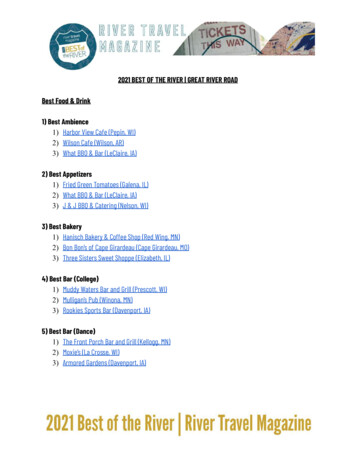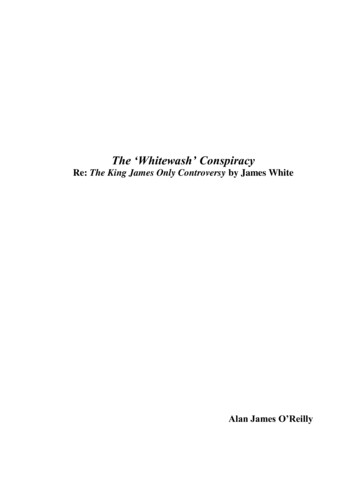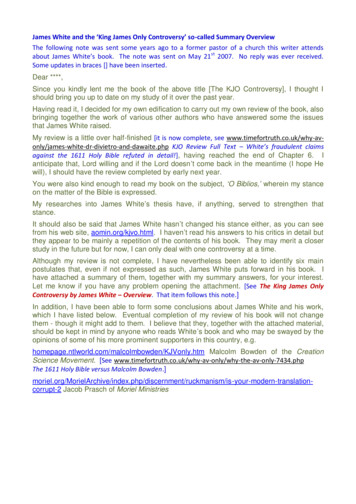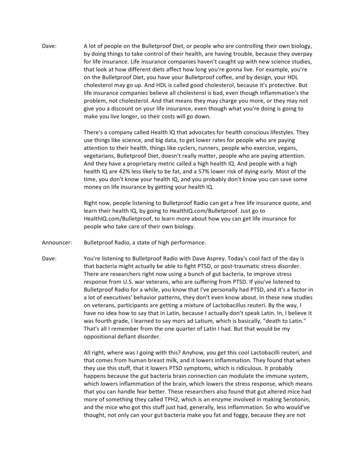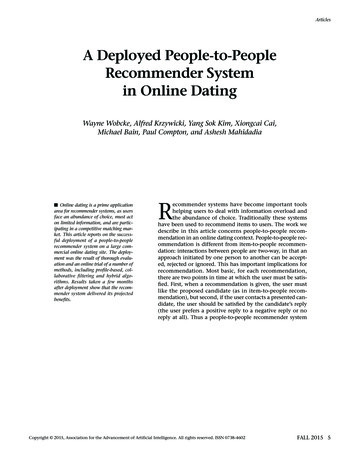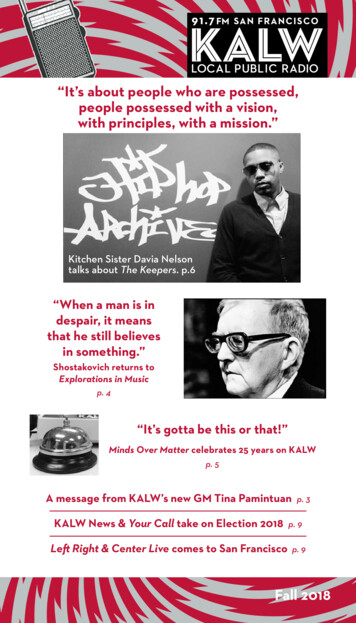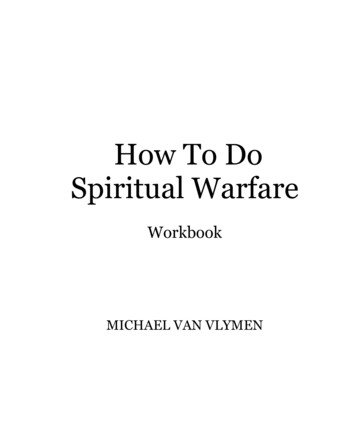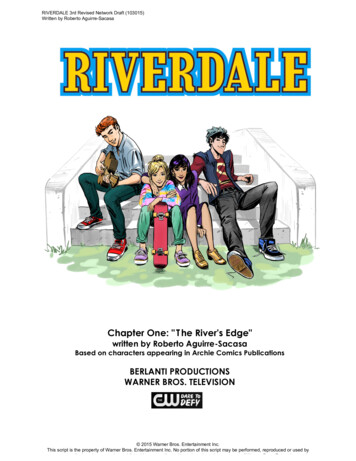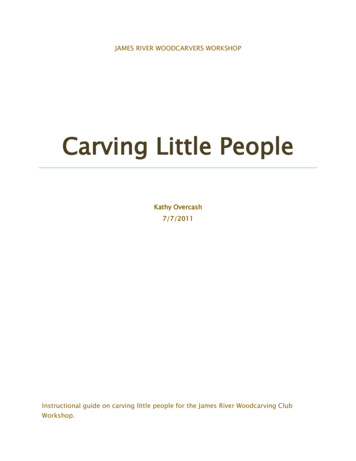
Transcription
JAMES RIVER WOODCARVERS WORKSHOPCarving Little PeopleKathy Overcash7/7/2011Instructional guide on carving little people for the James River Woodcarving ClubWorkshop.
Copyright 2011 by Kathy Overcash for James River WoodcarversAll rights reserved. No part of this work may be reproduced or used in any form or byany means—graphic, electronic, or mechanical, including photocopying or informationstorage and retrieval systems—without written permission from the copyright holder.Woodcarving groups may use this document for workshops.This document is meant for James River Woodcarvers club members and for personaluse. It is not intended for commercial applications or manufacturing purposes.
Table of ContentsOverview .4Carving Little People .4Recommended Tools.4Wood .5Pattern .5Carving Recommendation .6Rough Out Carving.7Rounding Hat .7Round Out Corners (Study Board Stage 1) .7Rough Out Hat (Study Board Stage 2) .7Rough Out Front and Back (Study Board Stage 3) .8Rough Out Sides (Study Board Stage 4).10Face (Study Board Stage 5) .11Detailed Carving (Study Board Stage 6) .14Finishing .16
OverviewThis pamphlet is written for the JRWC workshop, Carving Little People. The littlepeople are carved from a 1X1X2 inch piece of Basswood. I prefer to carve my littlepeople with long beards, so that‟s what we‟re going to do. My men are a little squattywith big heads. The carver can take the basic pattern supplied during the workshopand adjust it to create different little people.My ideas for the pattern came from across between Harold L. Enlow‟s “Rufus” in his “Carving Figure Caricatures in the OzarkStyle” book and Jack Price‟s little people in “Carving Small Characters” book. The clubhas a copy of “Carving Figure Caricatures in the Ozark Style” that you can check out ifyou are interested in Hillbilly people.Carving Little PeopleRecommended ToolsUse tools that you feel comfortable carving with. The following is a list of tools that Iprimarily use to carve most of my little people. The little people can be carved byusing only one knife. It‟s easier for me to use multiple tools to carve the little people.A carving glove and thumb guard is highly recommended because of the size of thelittle people. During the workshop, you‟re welcome to borrow some of my tools, sodon‟t go out and buy additional tools for the workshop.Carving gloveThumb guardRough out knifeNarrow blade knife (optional)¼” 45 degree V-Tool (optional)1 mm 45 degree V-tool (optional)U-Gouges (optional)o11/3 U-gougeo7/4 U-gougeo1mm (micro) U-gougeAbout a 1X1X2 inch basswood blockTacky glue for pattern
Pencil (preferred) or marker that won‟t bleedWoodI use a one inch thick basswood board to cut my blocks from. I noticed that the“advertised” one inch is not quite one inch thick. My husband, Dennis, sets up hisband saw for me to cut my blocks. He sets the fence to match the thickness of theboard so that the width is the same on each side (not quite one inch). I cut my piecesjust a little over two inches long to account for the amount of wood removed for thehat and sanding off the saw marks from the bottom of the piece. If you sand thebottom before carving, you should measure your piece at two inches.PatternYou don‟t necessarily need a pattern. Jack Price just draws a rough outline on thepiece and starts carving. For this workshop, I thought the patternmight help to visualize what we are trying to carve. The patternwe will be using is all my creation, so it is a long way from beingperfect. I‟m not an artist! Use the pattern as a guide and adjust asneeded. I don‟t recommend carving right up to the lines on thepattern. Give yourself some room to adjust, especially since it maynot be proportional. I‟m using this pattern to create the studyboard so I‟ll let you know if something needs to be adjusted.Gluing the Pattern OnThere are two ways to get that pattern transferred onto your block of wood. You caneither use tracing paper to transfer the pattern or glue the pattern to the block ofwood. The blanks I have will have the pattern glued on already so we can start carving.But, if you do this on your own, you can reference the method I‟ve outlined here. I useAleene‟s “Tacky Glue” to glue on the pattern. Don‟t use any glue that will seep into thewood. We really just need a temporary pattern. We‟ll end up carving it off. There aresome tricks to getting the patterned laid out properly on the wood. Lessons learned!Mark the Center: Draw an X, from corner to corner, on thetop and bottom of the block of wood. Drawing this X will
help you figure out where the center of your piece is carving the hat and shoes.Front Pattern: Begin by gluing the pattern with the little man facing forward.Try to center the pattern from elbow to elbow. Leave a small gap at the bottomof the piece so you can sand the saw marks off later. If you want, you can sandthe bottom before gluing the pattern on. Once the pattern is glued on, draw astraight line on the bottom of the block from the outer shoe sole parallel to theback. Don‟t draw the line from the top of the turned up shoe. Use the straightline of the bottom of the shoe (before it turns up - see image). This will helpposition the back pattern of the man, using the shoes as the guide.Right Side Pattern: Align the top of the hat with the top of the hat‟s brim on thefront, the best you can. This is an estimate, so don‟t worry if it isn‟t exact. Forthe pieces I‟ve cut, the brim fits pretty good from front to back. Watch thealignment of the shoes. Try to get them to the same parallel at the base withthe shoes in the front. After gluing the pattern on, draw guidelines for theseshoes on the bottom of the block. Draw the first line from the back of the heelparallel to the opposite side of the block. Draw the second line from the tip ofthe shoe parallel to the opposite side of the block.Back Pattern: Glue and align the back pattern opposite the front. Obvious, right?But it‟s easy to not notice which side you‟re on. Align the outer side of the shoeheels with the lines drawn from the Front Pattern above. Make sure there is aslight gap between the sole and the base of the wood just like the other threepieces.Left Side Pattern: Glue and align the left side pattern. Align the shoes with thelines drawn from the Right Side Pattern above.Now that the pattern is in place, let‟s start carving.Carving RecommendationBefore we actually start, these guys are small. The little man is right inside the surfaceof that block, not too deep. So when carving the excess wood away, make little cuts,little chips, little slivers to carve out the little man! Since most of carving is “with” thegrain, it would be easy to start a big cut and end up losing half of your man. He‟s
small enough, don‟t make him smaller. But, if it happens, grab another block and startagain! It won‟t take long to catch up.Rough Out CarvingDuring the initial stages, we want to focus on roughing out the man. We will carve inthe details later.Rounding HatWhere‟s the Hat?A hat is an indication of social status, so our little man needs a hat. My little man likesa slightly floppy Indiana Jones style hat. First thing we want to do is relieve the hatfrom the block of wood.Round Out Corners (Study Board Stage 1)Using a rough out knife, remove the corners of the block of wood by rounding the hatfrom just below the bottom of the brim to the top of the piece of wood.You can start removing the corners of the block fromright above the elbow as well and work your way at anangle to below the brim. From the brim up, the hatarea should look like a cylinder. Draw your hat lines back on. Try touse a non-bleeding pencil or marker. For example, don‟t use aSharpie. This guy is so small that you can end up carving away a bigchunk of wood by trying to remove the marked lines. I‟m usingPrismacolor Premier 03 fine line marker so you can see the lines in the photos. Eventhe Prismacolor brand bleeds a little, but not as bad as the Sharpies. Draw an extra lineabove the line you just drew to indicate the thickness of the hat‟s brim. During thedetailed carving stage we will smooth the squared off edge of the brim.Rough Out Hat (Study Board Stage 2)Upper Brim: The upper brim will be angled slightly to give the hat strength. Don‟t cutstraight across and then straight up. The brim will be brittle if youtry to carve it straight across. You can “sand” the brim thinner ifneeded when you are almost finished with the piece. With a narrowbladed knife (or the tip of a wider knife), carve away the excess wood
from the hat above the brim (top line you drew on) to the top of the crown. The bestway to shape the hat is to turn or curve the blade as you make the cuts. Cut in at aslight angle from the edge of the brim and then curve the blade up to form the crown.When you make a cut, rotate your piece and make an overlapping cut next to the oneyou just made (circling the hat). Once you‟re back at the position you started make thecut deeper and go around the hat again. This helps to keep the hat even. Whencarving the crown of the hat, carve the back at a slight angel to tilt the hat. Whenlooking down at the „X‟ on the hat, there should be less wood on the front of the hatthan the back. I generally carve the crown of the hat in an egg shape, more narrow inthe front that the back. Make the crown of the hat slightly larger around than what thesize of the head will be. Continue carving around the hat over and over until you getthe size of the crown you want on your man. Reference the pattern when needed.Clean off any saw marks if needed. And take off the rough edge from the top of thecrown. It‟s okay if your hat brim isn‟t exactly even. It‟ll add character!Using a 1/4” or 1mm 45 degree V-tool, outline the underside of the brim. A knife canbe used to create the V cut as well. At this point we are just outlining the bottom ofthe hat‟s brim, so don‟t cut in too deep.That‟s it for the hat for now. We‟ll carve in the details after we finish the face.Rough Out Front and Back (Study Board Stage 3)BacksideRedraw the back of the hairline on the side patters. Starting on the back, carve off theexcess wood following the outline of the patterns on each the side of the patterns.About 1/16” to 1/8th of an inch needs to be removed fromunder the hat brim (to hairline) to the bottom of the littleman‟s shoes (back of heel). When carving the back, keepthe sides blocked off. Watch out for the alignment of theside patterns. They may not line up exactly with eachother. Pick one that matches with your hat the best andstick with that one.
Back of HeadMake stop cuts under the brim of the hat when carving the back of the head. Toprevent chipping or breaking the brim, don‟t put pressure against the brim of the hatwith your knife. Use a V-tool to outline the bottom of the hair.BackCurve the back from the little man‟s bottom up to the hairline, following the pattern onthe sides.Back of Knees and LegsCarve the basic form of the legs and shoes. Start in the back and carve the back of thelegs in a V-shape, keeping the sides square. Use a V-tool to get a starting cut alongthe backs of the knees. Make stop cuts and continue to carve the backs of the legsand knees.ShoesNow let‟s see if we can find those shoes. Carve down the excess wood from the backof the shoes. The shoes should be carved down to the line drawn on the bottom of theblock of wood. We aren‟t actually carving out the shoes yet. Keep the sides square.FrontShoes and LegsUse the V-tool to carve a groove between the bottom of the beard and the top of shoe.The V-tool is used just to get started. You can also start with a knifeand begin carving out the legs and shoes. Continue to carve out thefront of the legs and the tops of the shoes. Carve away the wood up tothe line drawn on the bottom of the piece. From looking at each sidecarve the underside of the shoe at an angle. Some of the wood on eachside of the beard needs to be removed to carve down to the legs.Face and BeardThere is quite a lot of wood on the face and beard left. We need to remove some ofthe excess and round off the edges. This is a rough rounding, so don‟t carve too deepat this point. Carve down the face and beard about 1/16” deep below the brim of thehat. Use stop cuts at the brim of the hat to prevent chipping or breaking the brim. Use
slow short cuts when carving toward the brim. Watch the side patterns to ensure youdon‟t carve too close to the man‟s nose. From the side patterns, begin rounding offthe corners starting from the back of the man‟s beard (on side view) to the center ofthe face (on front view) at about a 30 degree
07.07.2011 · using only one knife. It‟s easier for me to use multiple tools to carve the little people. A carving glove and thumb guard is highly recommended because of the size of the little people. During the workshop, you‟re welcome to borrow some of my tools, so don‟t go out and buy additional tools for the workshop. Carving glove Thumb guard Rough out knife Narrow blade knife (optional) ¼” 45 .
